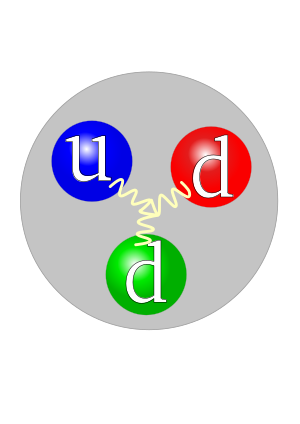Daunenquark
Down-Quarks (manchmal als "d" geschrieben) sind sehr kleine Teilchen, aus denen sich viel größere Teilchen wie Protonen und Neutronen zusammensetzen. Down-Quarks haben eine Ladung von -1/3. Da Down-Quarks Fermionen sind (was bedeutet, dass keine zwei von ihnen zur gleichen Zeit im gleichen Raum existieren können), haben sie einen Spin von 1/2. Abwärtsquarks sind die zweitleichtesten Quarks, wobei die ersten up-Quarks sind.
Das Antiteilchen eines Down-Quarks ist ein Down-Antiquark, oder einfach ein Antidown.

Zwei down-Quarks (d) und ein up-Quark (u) bilden ein Neutron
Fragen und Antworten
Q: What are Down quarks?
A: Down quarks are very small particles that help make up many larger particles, like protons and neutrons.
Q: What is the charge of Down quarks?
A: The charge of Down quarks is -1/3.
Q: What is the spin of Down quarks?
A: Down quarks are fermions and have a spin of 1/2.
Q: How do Down quarks compare to up quarks in terms of their weight?
A: Down quarks are the second lightest quark, with up quarks being the lightest.
Q: What is the antiparticle of a Down quark?
A: The antiparticle of a Down quark is a Down antiquark, or simply an antidown.
Q: Can two Down quarks exist in the same space at the same time?
A: No, Down quarks are fermions, which means no two of them can exist in the same space at the same time.
Q: What is the symbol for Down quarks?
A: Down quarks are sometimes written as a "d".
Suche in der Enzyklopädie